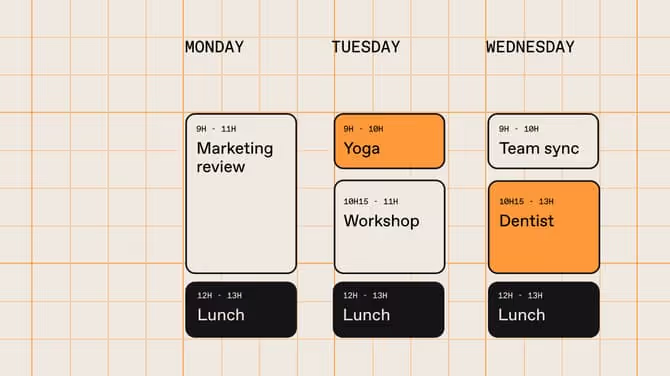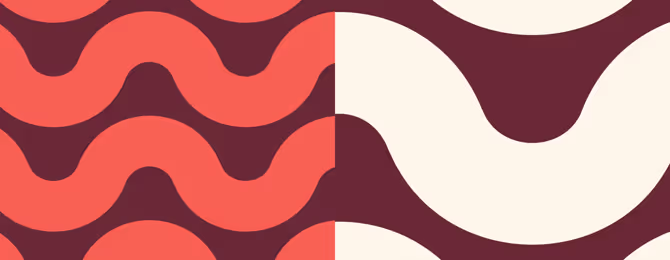How workplace flexibility boosts productivity, morale, and wellness

Discover Workleap Officevibe's benchmark report on 12 key employee engagement metrics

Picture this scenario: A manager is trying to keep their team’s productivity and happiness levels high, but the traditional 9-to-5 format is starting to show its limitations. Maybe their team is remote, spread across time zones, or each employee has varying personal realities requiring different work-life balance support. Sounds familiar?
The world has changed, and so have the ways we work. Traditional methods of ensuring team productivity and satisfaction — like mandatory office hours and physical presence— are no longer effective… or desirable. Today’s employees crave flexibility, and a manager’s priority is ensuring that their teams are productive and satisfied.
This is where workplace flexibility comes in.
What is workplace flexibility?
Workplace flexibility is any approach to work that accommodates the diverse needs of both employers and employees — in other words, flexible work arrangements. It’s all about creating environments that make work a win-win for everyone. This typically includes practices like flexible work hours, flexible scheduling, and flexible workspaces.
Flexible work hours
Flexible work hours mean employees have the freedom to choose when they work. That doesn’t mean managers cut slack on performance — it just means that working hours can take different forms within agreed-upon limits. Flexible work hours can help employees avoid rush hour commutes or work during personal peak productivity times.
Let’s say an employee is more energized, creative, and productive later in the day. Rather than forcing them to start at 9 a.m. sharp, they start at 11 a.m. and work until 7 p.m. A full day’s work is still done, but with better outcomes.
{emphasize}
Let’s say an employee is more energized, creative, and productive later in the day. Rather than forcing them to start at 9 a.m. sharp, they start at 11 a.m. and work until 7 p.m. A full day’s work is still done, but with better outcomes.
{emphasize}
Flexible scheduling
Flexible scheduling is a slight variant of flexible hours, where employees have control over the days they work (and the days they take off). Most people have experience with flexible scheduling types, such as part-time work or even sabbaticals. But compressed workweeks, like a 9/80 schedule (where employees work 8 nine-hour days over two weeks rather than 10 eight-hour days), are becoming increasingly popular.
{emphasize}
Think of an employee with childcare requirements. With a compressed work week, they can complete their 40 hours weekly over four days instead of five, so they can attend to family duties on Fridays.
{emphasize}
Flexible workspace
Flexible workspace means giving employees the choice of where they work — be it from home, a coffee shop, or the office. We often refer to this as remote work or hybrid work models, where local employees can split their time between workspaces and fully distributed teams can work from various global locations.
{emphasize}
If an employee has a long commute, they might elect to reserve the days they come into the office for team meetings and creative sessions where in-person collaboration is more impactful. The rest of the time, they choose to work from home, focusing on independent work duties (while saving time on travel).
{emphasize}
More and more, flexible arrangements are becoming commonplace in modern workplaces. And that’s because they pay off! Workplace flexibility not only enhances productivity but also boosts employee morale and wellness.
Why should managers care about workplace flexibility?
Workplace flexibility can be a real game-changer — not just for employees but for employers, too. We’re talking about increased productivity, higher employee satisfaction, better work-life balance, and improved employee retention. It’s no wonder leaders now see flexible work as a true strategic asset to business success. Here are four reasons why workplace flexibility should be considered.
1. Boosting employee productivity
Flexible work arrangements can significantly enhance productivity. Think about it — if employees save time and reduce stress by avoiding long commutes, they can work during their most productive hours.
{emphasize}
According to a Stanford study, remote workers are 13% more productive than their office-based counterparts, take fewer sick days, and experience quieter work settings.
{emphasize}
2. Enhancing employee engagement (and satisfaction)
Happy employees are productive employees. And employees who have autonomy over their work schedules and locations report higher job satisfaction. Flexibility allows for a level of autonomy that leads to more engagement and motivation.
{emphasize}
Employees value the trust and autonomy that come with flexibility. A People Management LinkedIn Poll revealed that 77% of employees reported flexible work as more important than a pay rise.
{emphasize}
3. Improving work-life balance
Work-life balance has become a modern-day HR priority, as better balance means healthier, more engaged employees. Flexibility in work hours and locations allows employees to manage their personal and professional lives more realistically, which is crucial for overall well-being.
{emphasize}
Gallup research reveals that 54% of employees would switch jobs for one that offers more flexibility. Soon, employers who aren’t accommodating of worker needs will be left at a disadvantage.
{emphasize}
4. Retaining top talent
You could say workplace flexibility is a magnet for talent. Companies that implement flexible work policies demonstrate they care about the employee experience and have more success in attracting prospective employees as well as in employee retention.
{emphasize}
Global directory Flexa tallied the numbers: 58% of job seekers are looking for roles with remote work options. In other words, companies offering flexible work models are more likely to attract and keep top talent.
{emphasize}
Overcoming challenges in flexible work arrangements
The benefits of workplace flexibility are clear. That said, adopting flexibility isn’t without its hurdles. Managers should be aware of these potential challenges — and the right approaches to overcome them.
Communication barriers
Remote and flexible work can sometimes lead to communication gaps. This could be due to team members with different schedules working asynchronously or too many remote communication options, which can be overwhelming.
{emphasize}
Here, structure is key. Managers can easily bridge communication gaps by:
- Implementing regular check-ins using video conferencing tools
- Using collaborative platforms to keep everyone connected
- Creating dedicated communication channels with clear guidelines
{emphasize}
Maintaining team cohesion
Keeping a team united while working flexibly requires a little bit of intentional effort — although no more than what’s required with any other kind of management. It’s all about adapting to flexible arrangements’ unique realities.
{emphasize}
To maintain team cohesion, managers can consider:
- Organizing virtual team-building activities to foster connection
- Nurturing inclusivity so remote workers feel as valued as in-office peers
- Encouraging the use of shared tools
{emphasize}
Ensuring equitable treatment
Because flexible arrangements can look different from one employee to the next, fairness is crucial. Flexible work policies should be applied equitably to avoid favoritism or resentment.
{emphasize}
Here’s how managers can ensure equity is at the center of workplace flexibility:
- Setting clear guidelines for flexible work arrangements applicable to everyone
- Monitoring the impact of these arrangements and how they affect team dynamics
- Asking employees to share feedback to address imbalances
{emphasize}
Future trends in workplace flexibility
The future of work is increasingly flexible, driven by tech advancements and evolving workforce expectations. Here’s what to watch for, taking a cue from how forward-thinking companies are setting the stage for a more adaptable, productive, and employee-centric future:
Hybrid work models
Combining remote work with in-office days is becoming the norm. This hybrid approach combines the benefits of remote work, such as fewer commutes and daytime disruptions, with the advantages of in-person collaboration, where creativity, communication, and connection thrive.
{highlight}
Microsoft allows employees to work from home 50% of the time. This hybrid work model demonstrates trust and allows employees to be in charge of their workloads.
{highlight}
Advanced collaboration tools
New technology, such as VR meetings and AI-driven project management tools, is continuing to make collaboration even more seamless, regardless of location. In fact, you might already be using a few without even realizing it!
{highlight}
Slack has a suite of integrated AI tools to streamline project management and communication. Slack Connect enables inter-company collaboration, while its huddle feature allows for quick, informal chats.
{highlight}
Emphasis on employee wellness
HR leaders won’t be surprised by this. Future flexible work policies will focus more on employee wellness, including mental health support programs and work-life balance initiatives. The healthier employees are, the better they show up for work.
Wondering how you stack up? Become a true EX leader by leveraging the insights from our Spring 2024 Employee engagement benchmark report.
Practical steps for implementing flexible work arrangements
Ready to make flexibility work for your team? As a leader, here’s a cheat sheet to create a more flexible work environment step-by-step:
1. Assess your team’s needs
Before making any decisions, first understand your team's specific needs and preferences. Use surveys to gather this information—they can help gauge employee sentiment and identify areas for improvement through flexibility schemes.
{highlight}
Pro tip: Tools like pulse surveys are a quick and easy way to understand your team's flexibility needs.
{highlight}
2. Introduce flexible work policies
Once you’re ready to introduce new flexible work policies, clearly communicating what they are ensures everyone understands how they can be implemented—for themselves and their peers.
{highlight}
Pro tip: Like introducing new policies, managers want to avoid going from zero to 100. Retaining some structure, such as core hours for everyone, helps with incremental but scalable integration.
{highlight}
3. Foster a supportive culture
Supporting balance is more than flexible policies—it also lives through the company culture. Managers must model a flexible work mindset in their management styles, advocating for open communication and empathy.
{highlight}
Pro tip: Don’t save employee check-ins for performance-related discussions. Make sure to set aside one-on-one time with team members to chat about work-life balance, too.
{highlight}
4. Monitor and adjust
Regularly evaluating the effectiveness of flexible work policies means being ready to make changes based on employee feedback. An iterative approach will help you achieve a flexible and productive work environment with equally successful and sustained outcomes.
{highlight}
Pro tip: Data analytics tools help track productivity, employee satisfaction, and engagement levels and will help you make informed decisions about adapting your flexible work policies.
{highlight}
Where employee experience meets management: Tools to support flexibility across teams
More than a trend, workplace flexibility is a genuinely strategic approach to modern team management. By implementing flexible work arrangements, managers can increase employee productivity, job satisfaction, and overall employee morale and wellness. So, don’t fear workplace flexibility. Embrace it and watch your team thrive.
As the future of work and hybrid workplaces continues to evolve, staying ahead of the curve is crucial for employers to attract and retain the best talent. Discover how Workleap Officevibe can equip teams with the right tools to meet employees where they’re at.
Give HR and managers the clarity, confidence, and connection to lead better every day.


%20(1).avif)


.avif)
.avif)








